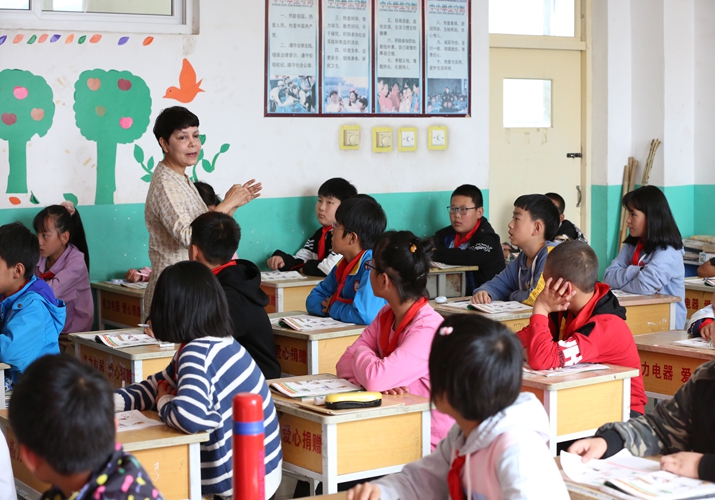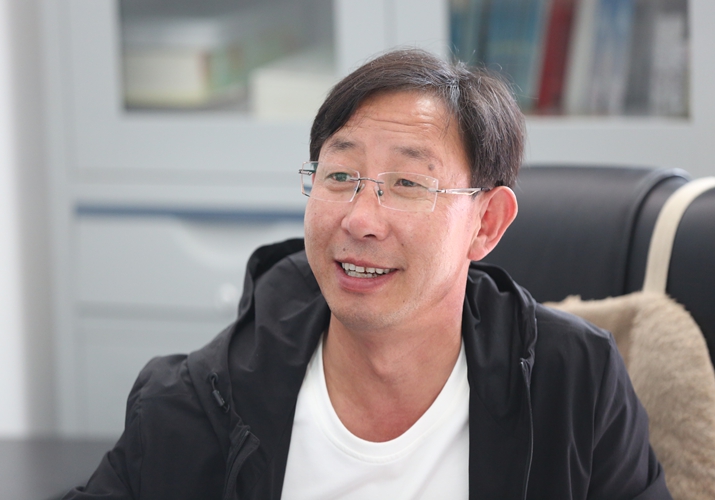A poor county becomes the face of China's rural education drive
Beijing Review by Sudeshna Sarkar,November 02, 2020 Adjust font size:

Sudeshna Sarkar, an editorial consultant with Beijing Review, teaches 12-year-olds at the Dongtuanpu Central Primary School, Laiyuan County, Hebei Province, north China (ZHANG WEI)
For museum enthusiasts who love to know more about China's history and culture through, well, museums, a hidden gem awaits their discovery in a rather unexpected place. This September, we went to a picturesque mountain county that despite being only three hours away from Beijing by car is almost on no general tourist's radar.
I came to know about Laiyuan, located in the city of Baoding in Hebei, the province adjoining Beijing, only at the fag-end of my decade-long stay in China. It is there that an experiment in education started, an initiative that is probably to rural education in China what the reform and opening up was for the Chinese economy in 1978.
The school we visited in Laiyuan, previously known as Taomugeda Primary School, back in the 1980s was nothing more than a tumbledown stone and mud shack; a sheep pen by night and the only school for children in the village, by day. In winter, the wind whistled in through the windows that had several panes missing and were curtained with tattered plastic sheets. The cold made the children, dressed in scraps and mostly barefoot, shiver. When it rained, the rainwater came down through the rickety roof, at times erasing the writing on the blackboard.
But when we went there, we were greeted by a modern whitewashed building with well-organized wings that besides the classrooms, included a music room, a computer room, a library and dormitories for students. There were decent football and basketball courts. It was the new avatar of the Taomugeda Primary School, renovated and renamed the Dongtuanpu Central Primary School. From the original 13 students, the school now boasts 328 students, we were told by the deputy principal of the school, Zhang Shangli.
Zhang's face looked familiar, though I had never met him before. Then it dawned on me where I had seen him before. His was among the arresting faces we saw in the photographs in an annexe we had to cross before reaching the main building. The annexe was a small but compact museum that told the story of the school, the rural educational experiment behind it that is known as Project Hope today, the stories of the students who have done the school and country proud, and the state leaders associated with the project.
From poster boy to principal
In 1988, Zhang was 12, and deeply unhappy. His father, a struggling farmer, had fallen ill and asked Zhang to quit school to help feed the family, including his several younger siblings. Zhang would go up into the mountains, collecting tree branches to cook the food. One photo in the museum shows the young boy carrying a large load of twigs on his head.
But Zhang wanted to study. The previous year, he and several other boys in the school had seen their first car. The man in the car had a kind face and spoke to the raggedy children in a kind way. Learning that they all attended school, he told them to study hard and he would help them go to college. Later they learned the visitor's name was Che Zhizong.
Che was the deputy chairman of the Laiyuan Committee of Chinese People's Political Consultative Conference, the political advisory body to the local government, and had come to assess how the village could be promoted as a tourism destination to end the rampant poverty there. For Zhang, that fateful meeting had left a deep mark on his mind and on an impulse he scribbled a letter to the official.
"Dear Uncle Che," he wrote, "We badly want to go to school, but our family is poor, and our father can't afford our tuition fees. We want to be learned and be someone like you, who makes the country proud."
Besides Zhang, Che's daughter Xiaoqiao also pieced together the story for us, a story which has since become well chronicled by both media and individuals writing about education in China.
Che is now 82. A fall about two years ago left him severely debilitated, practically unable to speak. Yet he closely followed his daughter recounting the story, sometimes nodding in agreement.
When Che got the letter, as luck would have it, the Central Committee of the Communist Youth League of China and China Youth Development Foundation had been asked to help school dropouts in rural impoverished areas continue their education. Che suggested the two organizations start the project, Project Hope, by sponsoring the education of the 13 children, and the proposal was accepted. That is how in 1989, the group of 13 got a new lease of life.
"If I had not received the help that I did, I would have been either a beggar or a low-skilled migrant worker," Zhang told us. "Education and technology are the two most important things that can change the fate of those who would otherwise remain in poverty forever. If a family had just one college graduate, that single graduate's earnings could pull the entire family out of poverty."
His words were almost an echo of U.S. economist Jeffrey Sachs'. At a webinar on how to end poverty in China as well as in the U.S. on October 13, Sachs, Director of the Center for Sustainable Development at Columbia University, said technological changes today, leading to the digitalization of society and the economy, have left at least half of American households without college education falling further and further behind. Education remains paramount in the struggle to attain a reasonable livelihood.

Zhang Shangli, Deputy Principal, Dongtuanpu Central Primary School, Laiyuan County, Hebei Province, north China (SHI GANG)
A welcome generation gap
The reverse is that lack of education or in the worst case, illiteracy, breeds poverty. Across rural, remote and inaccessible areas, illiteracy is handed down from generation to generation, and along with it, poverty.
Chinese leaders have been well aware of this. In 2015, on the eve of National Teachers' Day, September 10, in a message to teachers, President Xi Jinping said, "Reducing poverty must begin with reducing ignorance. Therefore, giving rural children a good education is an important task in poverty relief, and also a crucial means to stop poverty being passed on between generations."
That is why Project Hope was started in the 1980s, to ensure basic education across China's impoverished areas. During the Chinese People's War of Resistance against Japanese Aggression (1931-45) and the World Anti-Fascist War, mountainous Laiyuan was a revolutionary base of the Communist Party of China due to its inaccessibility. But when the war was over and Japan had surrendered, the mountains stood in the way of progress and prosperity. Therefore Project Hope decided to fund poor students there to halt the inter-generational transmission of illiteracy and poverty. By September 2019, the project built over 20,000 primary schools in poverty-stricken areas and helped 6 million students.
According to the school museum, in 1992, the education of one of these students, identified only by the surname Zhou, was sponsored by an anonymous donor. It was only years later that Zhou came to know the good Samaritan was none other than late Chinese leader Deng Xiaoping.
Zhang's story is a classic example of how one generation with education can break the chain of illiteracy and poverty. Zhang has two children. While the younger one is too young to go to school, the older is in college.
The story of education in China has been carried forward by people like Zhang who, grateful for the chance life gave them, decided to pay it forward. Zhang could have worked and lived in the big cities, but he decided to return to Laiyuan, which was one of the 10 most impoverished counties in Hebei.
Zhang explained his decision. China's poverty, he said, stemmed not from the big cities like Beijing and Guangzhou, but from the rural areas lacking education. "It made me decide to be a teacher in my hometown and teach those who cannot go to school due to poverty," he told us.
Today, Laiyuan has about 26 Project Hope schools.
In 2013, the county began to follow a 15-year free education policy, covering pre-school to high school in rural areas, with special attention given to control the number of dropouts. In 2019, the pre-school gross enrollment rate was 99.78 percent while primary and junior high school enrollment rate was 100 percent, according to the local government.
Che continues to contribute to children's education. His daughter continues his work by providing books, clothes and medical care for youngsters from impoverished families. When we visited him, we were introduced to a seventh grader who calls him "grandfather." The teen comes from a poor family and her father is mentally ill. While her education is public-funded, she gets much-needed family support and nurturing from the Che family.
The teenager, Dong Haiyan, wants to be a doctor, influenced by the heroism medical workers showed during the peak of the novel coronavirus epidemic in China. Time will tell if her wish comes true. But even if she doesn't become a doctor but continues her education to eventually stand on her own feet, it will be another case where one generation finally puts an end to the transmission of poverty.
(Zhang Shasha contributed to this article)
c8fe5670-0b92-4905-88dc-c537277a276b.jpg)